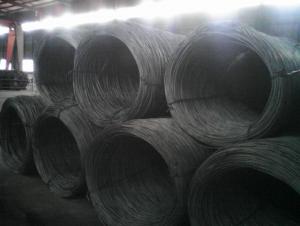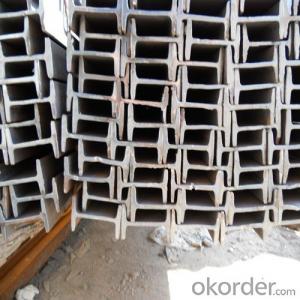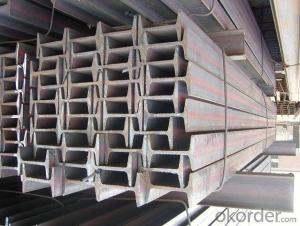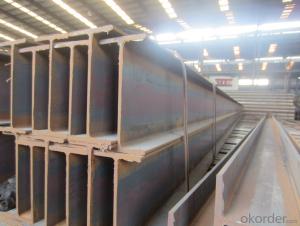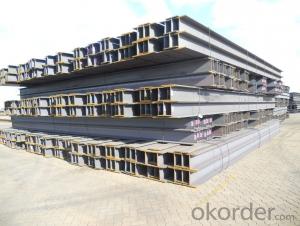Hot Rolled Structual Carbon Steel H-beam Bar
- Loading Port:
- China main port
- Payment Terms:
- TT or LC
- Min Order Qty:
- 25 m.t.
- Supply Capability:
- 1000 m.t./month
OKorder Service Pledge
OKorder Financial Service
You Might Also Like
Product Description:
OKorder is offering high quality Hot Rolled Steel I-Beams at great prices with worldwide shipping. Our supplier is a world-class manufacturer of steel, with our products utilized the world over. OKorder annually supplies products to European, North American and Asian markets. We provide quotations within 24 hours of receiving an inquiry and guarantee competitive prices.
Product Applications:
Commercial building structure ;Pre-engineered buildings; Machinery support structure; Prefabricated structure; Medium scale bridges; Ship-building structure.etc.
Product Advantages:
OKorder's Steel I-Beams are durable, strong, and resist corrosion.
Main Product Features:
· Premium quality
· Prompt delivery & seaworthy packing (30 days after receiving deposit)
· Corrosion resistance
· Can be recycled and reused
· Mill test certification
· Professional Service
· Competitive pricing
Product Specifications:
Manufacture: Hot rolled
Grade: Q195 – 235
Length: 6m – 12m, as per customer request
Packaging: Export packing, nude packing, bundled
H x B
(mm)
| T1 | T2 | JIS Weight
(kg/m)
| GB Weight
(kg/m)
|
100*100 | 6 | 8 | 16.9 | 17.2 |
125*125 | 6.5 | 9 | 23.6 | 23.8 |
150*75 | 5 | 7 | 14 | 14.3 |
148*100 | 6 | 9 | 20.7 | 21.4 |
150*150 | 7 | 10 | 31.1 | 31.9 |
175*90 | 5 | 8 | 18 | 18.2 |
175*175 | 7.5 | 11 | 40.4 | 40.4 |
198*99 | 4.5 | 7 | 17.8 | 18.5 |
200*100 | 5.5 | 8 | 20.9 | 21.7 |
194*150 | 6 | 9 | 29.9 | 31.2 |
200*200 | 8 | 12 | 49.9 | 50.5 |
248*124 | 5 | 8 | 25.1 | 25.8 |
250*125 | 6 | 9 | 29 | 29.7 |
244*175 | 7 | 11 | 43.6 | 44.1 |
250*250 | 9 | 14 | 71.8 | 72.4 |
298*149 | 5.5 | 8 | 32 | 32.6 |
298*201 | 9 | 14 | 65.4 | |
300*150 | 6.5 | 9 | 36.7 | 37.3 |
294*200 | 8 | 12 | 55.8 | 57.3 |
300*300 | 10 | 15 | 93 | 94.5 |
346*174 | 6 | 9 | 41.2 | 41.8 |
350*175 | 7 | 11 | 49.4 | 50 |
340*250 | 9 | 14 | 78.1 | 79.7 |
350*350 | 12 | 19 | 135 | 137 |
400*200 | 8 | 13 | 65.4 | 66 |
390*300 | 10 | 16 | 105 | 107 |
400*400 | 13 | 21 | 172 | 172 |
446*199 | 8 | 12 | 65.1 | 66.7 |
450*200 | 9 | 14 | 77.9 | 79.5 |
440*300 | 11 | 18 | 121 | 124 |
496*199 | 9 | 14 | 77.9 | 79.5 |
500*200 | 10 | 16 | 88.2 | 89.6 |
488*300 | 11 | 18 | 125 | 129 |
596*199 | 10 | 15 | 92.5 | 95.1 |
600*200 | 11 | 17 | 103.4 | 106 |
588*300 | 12 | 20 | 147 | 151 |
700*300 | 13 | 24 | 182 | 185 |
800*300 | 14 | 26 | 207 | 210 |
900*300 | 16 | 28 | 240.1 | 243 |
Payment:
-Invoicing on theoretical weight or actual weight as customer’s request.
-FOB, CFR or CIF.
-Regular terms of payment:
1, 30% payment in advance, the remaining balance (70% payment) against the copy of B/L. 100% payment before shipment.
2, 30% payment in advance, the remaining balance (70% L/C) against the copy of B/L. 100% payment before shipment.
3, Negotiable.
Production flow of Hot Rolled Steel H-beam For Sale
Material prepare (billet) —heat up—rough rolling—precision rolling—cooling—packing—storage and transportation
FAQ:
Q1: Why buy Materials & Equipment from OKorder.com?
A1: All products offered byOKorder.com are carefully selected from China's most reliable manufacturing enterprises. Through its ISO certifications, OKorder.com adheres to the highest standards and a commitment to supply chain safety and customer satisfaction.
Q2: How do we guarantee the quality of our products?
A2: We have established an advanced quality management system which conducts strict quality tests at every step, from raw materials to the final product. At the same time, we provide extensive follow-up service assurances as required.
Q3: How soon can we receive the product after purchase?
A3: Within three days of placing an order, we will begin production. The specific shipping date is dependent upon international and government factors, but is typically 7 to 10 workdays.
Images:


- Q: Can steel H-beams be used for industrial structures?
- Certainly, steel H-beams have proven to be a valuable option for industrial structures. In practice, they are widely utilized in the construction of a variety of industrial buildings and structures. These H-beams, which are also referred to as I-beams or universal beams, are specifically engineered to bear heavy loads and offer structural reinforcement. With a high strength-to-weight ratio, they are particularly well-suited for industrial applications where strength, durability, and stability are crucial. Warehouses, factories, power plants, and other industrial facilities frequently rely on steel H-beams to establish robust and dependable structures. Depending on the specific design requirements, these beams can be employed as columns, beams, or trusses. The adaptability of H-beams allows for diverse configurations and layouts, making them exceptionally suitable for a broad range of industrial construction projects. Moreover, steel H-beams provide numerous advantages over alternative construction materials. They possess fire-resistant, termite-resistant, and corrosion-resistant properties, ensuring the durability and longevity of the industrial structure. Additionally, steel is an environmentally sustainable and eco-friendly material as it can be recycled and reused, effectively reducing the environmental impact of the construction project. In conclusion, steel H-beams continue to be a favored choice for industrial structures due to their unparalleled strength, durability, and versatility. They offer the essential structural support and stability required for demanding industrial applications, making them an outstanding option for industrial construction projects.
- Q: How do steel H-beams perform in terms of durability?
- Steel H-beams are known for their exceptional durability. Due to their composition and design, they have high resistance to bending, warping, and twisting, making them highly durable even in demanding applications. Steel H-beams are made from strong and robust materials, such as carbon steel or alloy steel, which are known for their outstanding strength and longevity. Additionally, they are often hot-dip galvanized or coated with protective finishes, further enhancing their durability by preventing corrosion and rusting. These features make steel H-beams capable of withstanding heavy loads, extreme weather conditions, and other environmental factors, ensuring their long-term durability. Overall, steel H-beams are an excellent choice for structural applications where durability is a key requirement.
- Q: Specification for splicing length specification of H steel in steel structures
- The width of the splice shall not be less than 300mm and shall not be less than 600mm"
- Q: Can steel H-beams be used in the construction of commercial buildings?
- Yes, steel H-beams can be used in the construction of commercial buildings. These beams are commonly used in the construction industry due to their strength, durability, and ability to support heavy loads. They provide structural support and stability, making them suitable for commercial buildings that require robust and long-lasting construction materials.
- Q: How do steel H-beams contribute to sustainable construction practices?
- Steel H-beams contribute to sustainable construction practices in several ways. Firstly, they are incredibly strong and durable, allowing for the construction of long-lasting structures that require minimal maintenance and repairs over time. This reduces the need for frequent replacements, minimizing waste and conserving resources. Additionally, steel H-beams can be recycled at the end of their lifespan, reducing the demand for new steel production and lowering the environmental impact associated with extracting and manufacturing raw materials. Lastly, their lightweight nature allows for efficient transportation and installation, reducing energy consumption during construction. Overall, steel H-beams offer sustainability benefits through their durability, recyclability, and energy-efficient characteristics.
- Q: Can steel H-beams be used in bridge construction?
- Indeed, steel H-beams have the potential to be utilized in the construction of bridges. Their strength, durability, and versatility make them a popular choice for bridge construction. The unique H-shape of these beams enables them to efficiently bear heavy loads and withstand diverse environmental conditions. Moreover, the fabrication process for steel H-beams is simple and efficient, leading to cost-effective bridge construction. The success of numerous projects worldwide has solidified the status of steel H-beams as a favored option for engineers and contractors in bridge construction.
- Q: Are steel H-beams resistant to corrosion?
- Yes, steel H-beams are resistant to corrosion due to their protective coating or galvanization process, which helps prevent rusting and extends their lifespan.
- Q: What are the dimensions of a standard steel H-beam?
- The dimensions of a standard steel H-beam vary depending on the specific size and manufacturer. However, common dimensions for a standard steel H-beam may include a height ranging from 4 inches to 44 inches, with a flange width ranging from 5 inches to 40 inches. The weight per foot of an H-beam can also vary, typically ranging from 6 pounds to over 300 pounds.
- Q: What are the common sizes of steel H-beams available in the market?
- The market offers a diverse selection of steel H-beams with varying sizes to meet specific requirements and applications. Nevertheless, there are certain standard sizes that are commonly available. The height of these sizes typically falls within the range of 100mm to 1000mm, while the widths vary from 50mm to 500mm. As for the lengths, they also vary but are often found in standard sizes of 6 meters, 9 meters, or 12 meters. These commonly found sizes effectively address a wide range of construction and structural demands, enabling adaptability and flexibility in various projects.
- Q: Can steel H-beams be used in school gymnasium or sports facility construction?
- School gymnasiums or sports facilities can indeed utilize steel H-beams in their construction. These beams are widely employed in the building industry because of their robustness, endurance, and adaptability. They offer exceptional support and structural integrity, which makes them particularly well-suited for expansive areas such as gymnasiums and sports facilities. The H-shaped design of these beams enables them to bear heavier loads, making them an ideal option for structures that require substantial weight support. Moreover, steel H-beams are resistant to the effects of weathering, corrosion, and fire, guaranteeing the safety and durability of the construction. In summary, steel H-beams are a dependable and effective choice for constructing school gymnasiums or sports facilities.
Send your message to us
Hot Rolled Structual Carbon Steel H-beam Bar
- Loading Port:
- China main port
- Payment Terms:
- TT or LC
- Min Order Qty:
- 25 m.t.
- Supply Capability:
- 1000 m.t./month
OKorder Service Pledge
OKorder Financial Service
Similar products
Hot products
Hot Searches
Related keywords












